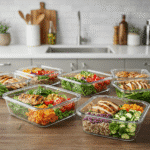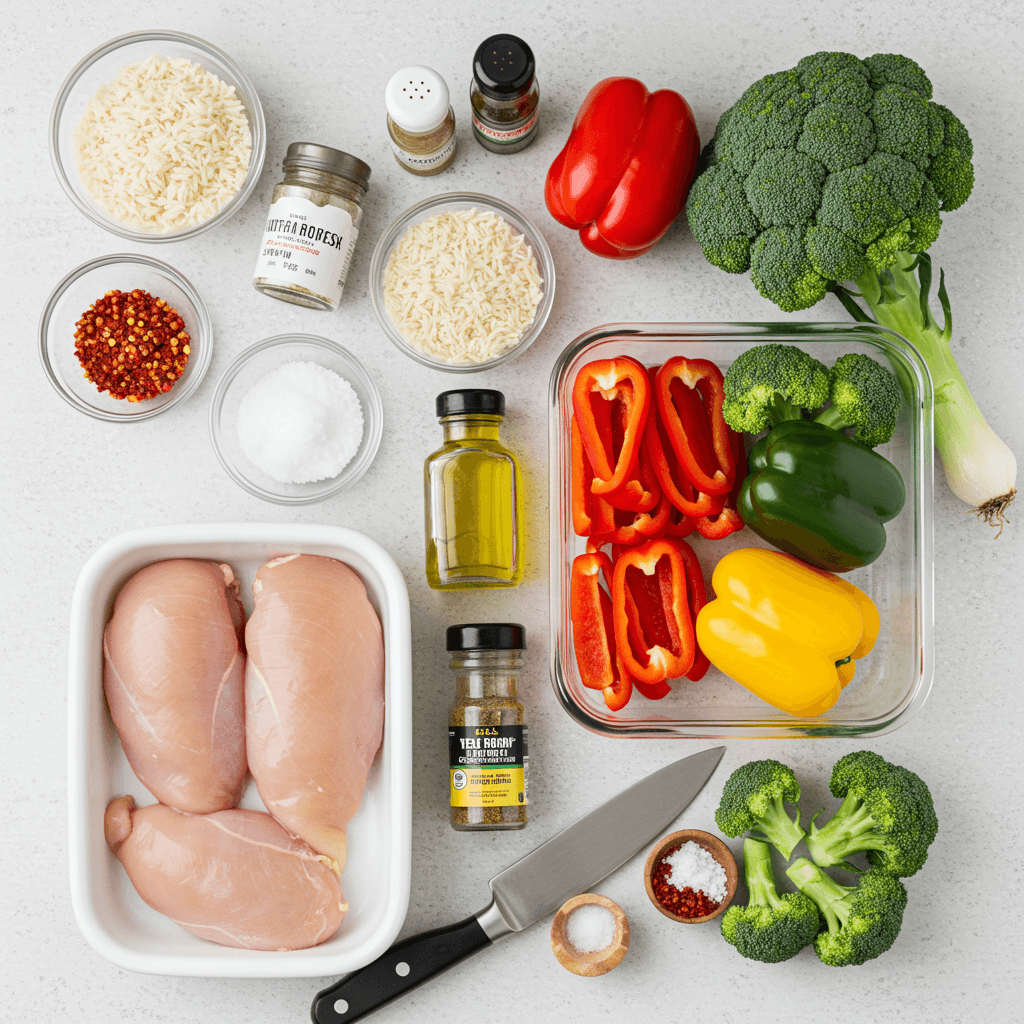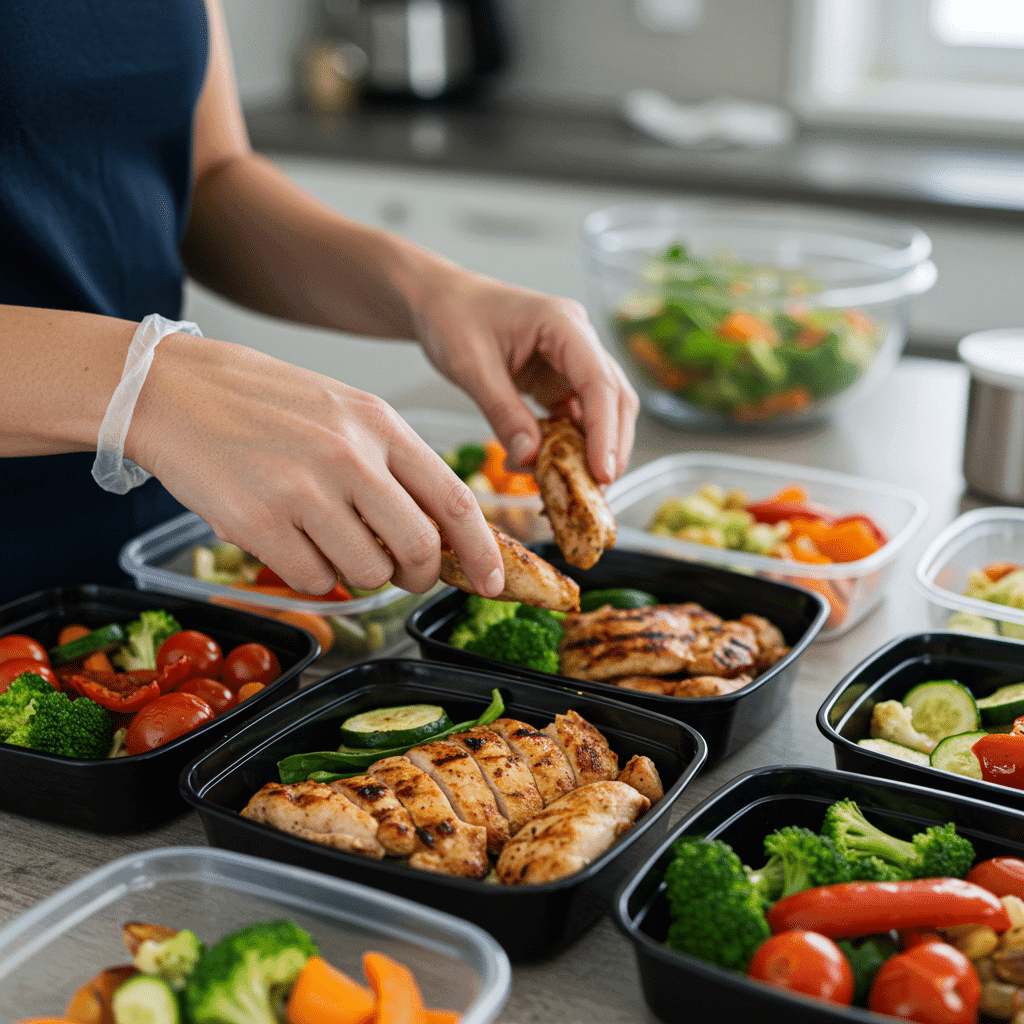Let’s be honest—if winging dinner was a sport, I’d be a gold medalist. I used to think meal prep was just for fitness fanatics with color-coded containers and a love for chicken breast. Spoiler alert: it’s not. It’s for anyone who’s tired of wasting time staring into the fridge, hoping dinner magically appears. This meal prep & planning guide is for real-life cooks who want structure without the stress. I’ll show you how I went from chaotic, last-minute meals to actually enjoying the rhythm of planning ahead—and you can do it too, without losing your personality or your tastebuds.
Table of Contents
How a Meal Prep & Planning Guide Changed My Kitchen—and My Life
When dinner felt like a daily disaster
There was a stretch in my life when dinnertime felt like defeat. I’d open the fridge, see a random mess of ingredients, and immediately feel overwhelmed. More often than not, I’d end up ordering takeout or throwing together something barely edible just to get by. The stress wasn’t just about food—it was the pressure of making a decision, every single night, without a plan. That’s when I realized I didn’t need gourmet skills. I needed a meal prep & planning guide that actually worked for real life.
I wasn’t looking for perfection. I didn’t want to cook every meal from scratch or spend Sundays in a prep frenzy. I just needed something flexible—a method to cut down on chaos and save time. So I started small. I picked three recipes I knew we liked, wrote out a quick grocery list, and blocked off 30 minutes to prep ingredients for the week. It wasn’t fancy, but it worked.
Print
Meal Prep & Planning Guide: Real Tips That Make Life Easier
- Total Time: 1 hour 40 minutes
- Yield: 4–5 meals 1x
Description
A flexible, real-life meal prep & planning guide that helps you prepare ingredients and organize your week without stress. This step-by-step method focuses on batching and rotation to save time, reduce food waste, and simplify cooking.
Ingredients
2 lbs boneless skinless chicken (or choice of protein)
2 cups cooked grains (rice, quinoa, couscous)
4 cups chopped vegetables (bell peppers, broccoli, carrots)
Olive oil, salt, pepper, garlic powder
Optional: sauces or dressings for variety
Instructions
1. Choose 3–4 meals for the week and write them down.
2. Create a shopping list from those recipes using shared ingredients.
3. Set aside 1 hour for prepping: cook proteins, grains, and veggies.
4. Portion prepped ingredients into containers.
5. Store in the fridge and reheat or mix for lunches and dinners.
6. Use weekly themes like tacos, sheet pan meals, or stir-fries.
7. Keep a visible plan on your fridge or planner.
8. Include one flexible “DIY” meal night for picky eaters or changes.
Notes
This guide is designed for flexibility. You can scale portions up or down.
Mix proteins, grains, and veggies for quick bowls, salads, or wraps.
Use the 3-2-1 method: 3 proteins, 2 veggies, 1 grain per week.
Store cooked items up to 4 days in the fridge or freeze for later.
- Prep Time: 60 minutes
- Cook Time: 40 minutes
- Category: Meal Prep
- Method: Batch Cooking
- Cuisine: American
Nutrition
- Serving Size: 1 container
- Calories: 450
- Sugar: 5g
- Sodium: 540mg
- Fat: 12g
- Saturated Fat: 3g
- Unsaturated Fat: 7g
- Trans Fat: 0g
- Carbohydrates: 38g
- Fiber: 5g
- Protein: 32g
- Cholesterol: 65mg
Keywords: meal prep & planning guide, beginner meal prep, batch cooking, weekly prep
That first week, something shifted. I had meals ready to go, and I felt a little more in control. That’s when I knew this meal prep & planning guide could become a game-changer for my kitchen.
More calm, less chaos—thanks to a simple plan
What surprised me wasn’t just how much time I saved. It was the mental relief. I wasn’t scrambling at the end of each day. I wasn’t wasting food or overspending at the grocery store. I had a system, and it actually made me enjoy cooking again. The best part? It was flexible. Some weeks I prepped just lunches, other weeks I focused on dinners. But the consistency made everything smoother.
I started pulling recipes from places I trusted, like this easy weeknight dinner roundup, and made sure they matched what we actually wanted to eat. I didn’t follow strict rules—I created a plan that fit my rhythm. That’s the whole goal of this meal prep & planning guide: to meet you where you are, not where social media thinks you should be.
As I kept going, I learned how to reuse ingredients, batch-cook proteins, and prep smarter. I even found little kitchen hacks that saved me on the busiest days—many inspired by practical ideas like these quick-prep family meals.
This guide isn’t about being perfect—it’s about being prepared. And if you’re ready to stop guessing and start planning, this meal prep & planning guide will help you build routines that work, week after week.

Starting Your Meal Prep & Planning Guide the Smart Way
Begin with what you already know and eat
If the idea of planning a full week of meals feels overwhelming, take a breath—you don’t have to do it all at once. The best way to start using a meal prep & planning guide is by working with what you already cook. Think about your go-to meals. What do you already enjoy making? What ingredients do you always have?
Start by listing 3 to 4 recipes that your household loves. Don’t overthink it. If you’re constantly rotating tacos, pasta, and baked chicken—great. Those become your anchor meals. From there, build your shopping list based on those dishes. Stick to ingredients that work across recipes so nothing goes to waste. Ground beef, bell peppers, rice, shredded cheese—those staples stretch across multiple meals.
This is where planning shines: instead of asking “what’s for dinner?” every night, you decide once, and prep accordingly. Having a plan reduces decision fatigue, cuts impulse buys, and lowers food waste.
Want something even easier? Use guides like this beginner-friendly dinner planner to shortcut the planning phase. They give you a place to start without having to create a system from scratch.
Tools and habits that actually help (not collect dust)
Let’s talk gear—but keep it simple. You don’t need a $300 blender or a 30-piece container set to follow a meal prep & planning guide. Start with a few clear, stackable containers, a reliable cutting board, and a slow cooker or sheet pan you trust. You probably already have most of what you need.
Where most people stumble isn’t in the tools—it’s in the timing. So here’s the habit that changed everything for me: schedule one hour, just once a week. That hour is for prepping ingredients, washing veggies, chopping onions, and cooking one or two components like roasted chicken or hard-boiled eggs. That alone can save you hours during the week.
Keep your plan visible. Use a whiteboard, notebook, or even a sticky note on the fridge. If it’s in front of you, you’re more likely to stick with it. Over time, you’ll develop your own rhythm—maybe Sundays are for prepping, maybe Wednesdays are for leftovers. There’s no wrong way to follow a meal prep & planning guide, as long as it helps you feel less stressed.
And if you’re short on time? Lean into recipes built for busy lives, like those in this quick prep dinner list, where the goal is flavor and speed, not perfection.
Batch Cooking and Weekly Rotations That Actually Work
Batch prep without overdoing it
One of the most practical tools inside any solid meal prep & planning guide is batch cooking. But let’s clear something up—you don’t need to prep entire meals for the week. The trick is to cook a few base ingredients that give you flexibility and speed when you need it most.
Think about what you use often. I usually start with two proteins like seasoned ground turkey and grilled chicken, a grain such as quinoa or jasmine rice, and a couple of easy vegetables. Roast a tray of carrots, sauté some spinach, maybe boil eggs while everything else is in the oven. It all comes together in under an hour.
This kind of foundation makes any meal prep & planning guide sustainable. You’re not locking yourself into full meals. You’re prepping smarter, so your week runs smoother. When you open the fridge and see cooked ingredients ready to go, making dinner becomes a five-minute task instead of a 45-minute stressfest.
You don’t need fancy equipment either. A cutting board, a sheet pan, and a few clear containers are enough to follow the system in this meal prep & planning guide.

Avoid repetition with meal theme nights
One of the top complaints I hear about meal prep? “I get sick of eating the same thing.” Totally valid. That’s why a good meal prep & planning guide encourages rotation. Not by cooking more—but by adding variety through structure.
Theme nights are a lifesaver. Instead of planning specific dishes, you just decide on the type of meal. Monday can be one-pot meals. Tuesday? Tacos or burrito bowls. Wednesday is for stir-fry. Thursday could be sheet pan dinners, and Friday is always leftovers or a “snack board night.”
This keeps things predictable but not boring. It lets you rotate ingredients while sticking to a flexible routine—a core feature of any meal prep & planning guide worth following.
Need ideas? I often pull from this quick-prep dinner roundup to keep meals interesting without making them complicated.
Let flexibility guide your week
If your meal prep & planning guide feels like a rigid set of rules, it’s time to reframe. Real life is messy. Some weeks, I prep every lunch and dinner. Other weeks, I’m lucky if I wash fruit and pre-cook some pasta.
The win comes from having a plan, not from sticking to it perfectly. This guide isn’t about locking yourself into rigid routines—it’s about giving yourself choices when you need them most. You’ll still eat well, even when the unexpected happens.
Use a visible plan—a whiteboard on the fridge, a planner, or a simple note on your phone. You’ll be shocked how much easier it is to stay on track when your meals are written out. This is one of the simplest shifts that makes a meal prep & planning guide effective long-term.
And when life gets chaotic? A flexible plan is your safety net. You’ve already thought ahead, made the prep, and saved yourself from another night of ordering takeout. That’s the power of a smart meal prep & planning guide—it gives you time back, mental space, and a kitchen you can count on.
Personalizing Your Meal Prep & Planning Guide for Real Life
Adapt your guide to match your lifestyle and goals
Every household runs differently—and your meal prep & planning guide should reflect that. Whether you’re cooking for one, feeding toddlers, or juggling a rotating work schedule, your plan needs to work with your life, not against it.
Start with your goals. Are you trying to save time? Eat healthier? Stick to a specific diet like gluten-free or plant-based? Write those down. A clear purpose will guide your choices when you’re planning meals and shopping.
For example, if you’re working on clean eating, you might prep extra vegetables, swap white rice for quinoa, or choose lean proteins. If your goal is simply fewer takeout nights, then just having a plan—even if it includes pasta and frozen veggies—is still a win.
One of the best things about using a flexible meal prep & planning guide is that you can shift your strategy from week to week. A busy week might call for freezer meals and slow cooker recipes. A quieter one may give you room to try something new, like sheet pan salmon or homemade soup.
Use tools that support your goals, too. A grocery app for tracking your list. A meal planner on your fridge. Or good old pen and paper. The method doesn’t matter—consistency does.
How to handle picky eaters without cooking twice
If you’ve got kids—or adults—who cringe at the idea of “meal prep,” you’re not alone. The beauty of a well-designed meal prep & planning guide is that it leaves room for flexibility and personalization, even within the same meal.
Here are a few tricks that work for families (or roommates) with different tastes:
- Create build-your-own bowls: Cook a base like rice or pasta, then offer a mix of toppings—grilled chicken, sautéed veggies, shredded cheese, sauces. Everyone assembles their own plate.
- Double up on base ingredients: Roast extra potatoes or chicken so you can season or serve them differently later in the week.
- Plan a “flex meal” night: One meal per week that can be customized or made last-minute based on what everyone feels like.
You don’t need to make separate meals—you just need to prep in a way that lets people mix and match. That’s why any smart meal prep & planning guide includes room for variety without doubling your workload.
And if you’re stuck, sites like this family dinner guide have plenty of options that are kid-approved, budget-friendly, and fast.
How to stay consistent—even when life gets chaotic
Let’s be real: some weeks, meal prep falls apart. You forget to grocery shop. Your schedule changes. You just don’t feel like cooking. That’s okay. One of the best things you can do is design your meal prep & planning guide with flexibility built in.
Here’s how:
- Keep a “backup meal” shelf: Stock it with things like pasta, jarred sauce, canned beans, frozen veggies, and tortillas. These can turn into dinner in 10 minutes if needed.
- Plan for leftovers intentionally: Make one meal that stretches across two nights, like chili or stir-fry.
- Use the “3-2-1” rule: Prep 3 proteins, 2 veggies, and 1 grain. This formula keeps your fridge stocked without overloading you.
And remember—it’s better to prep a little than to prep nothing. Even washing fruit or chopping a few onions can make your week easier. That mindset shift is what makes a meal prep & planning guide something you stick with long-term.
You’ll fall off track sometimes. We all do. What matters is picking it back up the next week, one small step at a time.

Frequently Asked Questions (FAQs)
What are the 5 rules in planning meals?
The core five rules in any effective meal prep & planning guide are
Plan with purpose – Know your goal (budget, nutrition, convenience).
Shop intentionally – Make a list that matches your plan.
Prep in batches – Focus on ingredients, not full meals.
Stay flexible – Leave room to swap meals when life gets busy.
Keep it visible – Post your plan on the fridge or inside your pantry.
Following these steps keeps your routine simple and sustainable.
How to start meal planning and prepping?
Start small. Pick 2–3 easy meals you already love and write them down. Make a short grocery list based on those meals. Spend 30–60 minutes prepping base ingredients like proteins, grains, or veggies. The key to success is not doing it all at once—but building habits over time. Your meal prep & planning guide will grow with you, week by week.
What are the 5 basic steps of meal planning?
A streamlined meal prep & planning guide usually follows these five steps:
Assess your schedule – Note which nights are busy or open.
Choose meals – Pick 3–5 dishes that suit your week.
Write a grocery list – Based only on what you actually need.
Do the prep – Wash, chop, cook, and store.
Conclusion: A Meal Prep & Planning Guide That Works With Real Life
Meal prep doesn’t have to be overwhelming. With a flexible meal prep & planning guide, you’re not just feeding yourself or your family—you’re making life smoother. You’re cutting down on stress, saving time, and getting one major part of your day handled before it even starts.
This guide isn’t about perfect meals or Pinterest-worthy containers. It’s about creating a rhythm that works for you. Whether you’re just starting out or fine-tuning your routine, the tips you’ve read here can help you build a plan that sticks—one week at a time.Need more real-life meal inspiration? Follow along for weekly prep visuals and fresh ideas on Pinterest at Easy Meals Ideas.